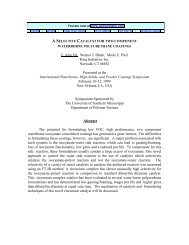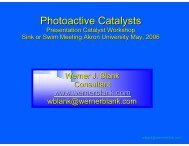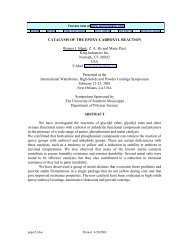Catalysis of the Isocyanate-Hydroxyl Reactions ... - Wernerblank.com
Catalysis of the Isocyanate-Hydroxyl Reactions ... - Wernerblank.com
Catalysis of the Isocyanate-Hydroxyl Reactions ... - Wernerblank.com
Create successful ePaper yourself
Turn your PDF publications into a flip-book with our unique Google optimized e-Paper software.
However, <strong>the</strong>re was no<br />
evidence in <strong>the</strong><br />
1 H NMR<br />
spectrum at low temperature <strong>of</strong><br />
a Zr-H bond. The rate <strong>of</strong><br />
exchange <strong>of</strong> <strong>the</strong> n-butanol into<br />
<strong>the</strong> <strong>com</strong>plex could be<br />
determined from <strong>the</strong><br />
temperature dependence <strong>of</strong> <strong>the</strong><br />
line widths.<br />
Figure 19. Zr(AcAc) 4 + 3 eq. n-butanol in d 8 -THF at -50 o C<br />
Figure 20. Zr(AcAc) 4 in d 8 -THF at 25 o C<br />
Comparison <strong>of</strong> <strong>the</strong> room<br />
temperature<br />
1 H spectrum <strong>of</strong><br />
Zr(AcAc) 4 (Figure 20) and n-<br />
butanol (Figure 21) with that<br />
<strong>of</strong> <strong>the</strong> corresponding spectrum<br />
at room temperature where n-<br />
butanol has been added shows<br />
that <strong>the</strong> presence <strong>of</strong> additional<br />
n-butanol causes significant<br />
broadening <strong>of</strong> all peaks. We<br />
also attempted to conduct a<br />
similar experiment with water<br />
instead <strong>of</strong> n-butanol. It was not<br />
possible to draw any<br />
conclusion from this<br />
experiment because <strong>of</strong><br />
hydrolysis <strong>of</strong> <strong>the</strong> zirconium<br />
<strong>com</strong>plex.<br />
Figure 21. n-butanol in d 8 -THF at 25 o C










